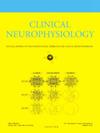调查边缘型人格障碍的视觉-触觉镜像特性:TMS-EEG 研究。
IF 3.7
3区 医学
Q1 CLINICAL NEUROLOGY
引用次数: 0
摘要
研究目的边缘型人格障碍(pw-BPD)患者的认知移情能力下降,这可能与体感皮层中的镜像机制(即触觉镜像系统(TaMS))有关。在此,我们旨在利用经颅磁刺激和脑电图(TMS-EEG),以连接性为重点,揭示触觉镜像系统(TaMS)和移情缺陷在 Pw-BPD 中的作用:研究预登记后,我们收集了 20 名 Pw-BPD 和 20 名健康对照者的共情能力自我报告测量结果、视觉-触觉空间一致性任务中调查 TaMS 活动的行为表现以及 TMS 诱发电位 (TEP)。在触觉观察和真实触觉传递过程中,在右侧初级体感皮层(S1)上传递 TMS:结果:与对照组相比,心理障碍患者的认知共情水平明显较低,在触摸观察过程中,他们在报告真实触摸的侧面时出现的错误也明显较多。此外,在触摸感知和触摸观察过程中,pw-BPD 的 S1-TEPs 连接模式发生了改变,在最后一种情况下,人类和物体引导的触摸之间没有差异:结论:本研究结果并不支持 pw-BPD 的 TaMS 存在特定障碍,但揭示了在触觉处理过程中躯体感觉网络内存在显著的行为和连接性改变:重要意义:本研究结果使TaMS在BPD中的作用有所缓和,同时仍强调了躯体感觉网络改变的参与。本文章由计算机程序翻译,如有差异,请以英文原文为准。
Investigating visuo-tactile mirror properties in borderline personality disorder: A TMS-EEG study
Objectives
Patients with borderline personality disorder (pw-BPD) have decreased levels of cognitive empathy, which may be subtended by mirror-like mechanisms in the somatosensory cortices, i.e., the Tactile Mirror System (TaMS). Here, we aimed to shed light on the TaMS and empathic deficits in pw-BPD focusing on connectivity, using transcranial magnetic stimulation and electroencephalography (TMS-EEG).
Methods
After study preregistration, we collected self-report measures of empathic abilities, behavioral performance in a visuo-tactile spatial congruency task investigating TaMS activity, and TMS-evoked potentials (TEPs) from 20 pw-BPD and 20 healthy controls. TMS was delivered over the right primary somatosensory cortex (S1) during touch observation and real touch delivery.
Results
Pw-BPD reported significantly lower levels of cognitive empathy than controls and made significantly more errors in reporting the side of real touches during touch observation. Moreover, pw-BPD presented an altered connectivity pattern from S1-TEPs during touch perception and touch observation, in the last case without differences between human- and object-directed touches.
Conclusions
The results do not support a specific impairment of TaMS in pw-BPD, but reveal significant behavioral and connectivity alterations within the somatosensory network during touch processing.
Significance
The present findings temper the proposed role of the TaMS in BPD, while still highlighting the involvement of somatosensory network alterations.
求助全文
通过发布文献求助,成功后即可免费获取论文全文。
去求助
来源期刊

Clinical Neurophysiology
医学-临床神经学
CiteScore
8.70
自引率
6.40%
发文量
932
审稿时长
59 days
期刊介绍:
As of January 1999, The journal Electroencephalography and Clinical Neurophysiology, and its two sections Electromyography and Motor Control and Evoked Potentials have amalgamated to become this journal - Clinical Neurophysiology.
Clinical Neurophysiology is the official journal of the International Federation of Clinical Neurophysiology, the Brazilian Society of Clinical Neurophysiology, the Czech Society of Clinical Neurophysiology, the Italian Clinical Neurophysiology Society and the International Society of Intraoperative Neurophysiology.The journal is dedicated to fostering research and disseminating information on all aspects of both normal and abnormal functioning of the nervous system. The key aim of the publication is to disseminate scholarly reports on the pathophysiology underlying diseases of the central and peripheral nervous system of human patients. Clinical trials that use neurophysiological measures to document change are encouraged, as are manuscripts reporting data on integrated neuroimaging of central nervous function including, but not limited to, functional MRI, MEG, EEG, PET and other neuroimaging modalities.
 求助内容:
求助内容: 应助结果提醒方式:
应助结果提醒方式:


